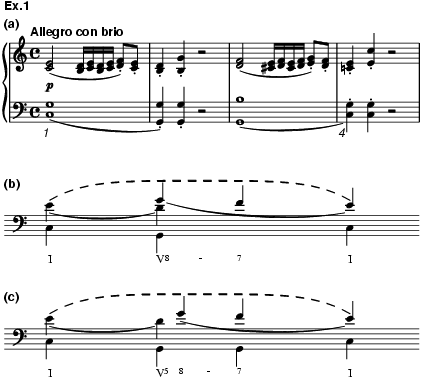
(Ger. Übergreifen).
In Schenkerian analysis (see Analysis, §II, 4), the juxtaposition of two or more descending lines in such a way that the resultant line appears to climb from an inner voice to the upper voice; each of the descending lines is called a reaching-over progression (Übergreifzug). The opening theme of Beethoven's Piano Sonata in C op.2 no.3 (ex.1a) demonstrates reaching over as a method of Prolongation whereby two notes that are conceptually simultaneous (ex.1b shows both d' and g' to be part of the same dominant chord) are heard in succession, the higher note following the lower (ex.1c). In this, its simplest form, reaching over enables the upper voice to maintain its registral position by falling by step (from e' to d'), leaping (from d' to g'), and falling again by step (g'–f'–e').

Schenker showed how reaching over could be extended to give the effect of an Arpeggiation (Der freie Satz, 1935, fig.101/5), and also how it could be used to change tonal centre, as shown in his analysis of the first movement of Mozart's G minor Symphony (Das Meisterwerk in der Musik, ii, 1926, p.121). The vast majority of examples in the Schenkerian literature show that the reaching over progressions descend, and do so by step. However, leaps may sometimes be employed (Schenker, 1935, fig.101/3) and there are instances of ascents in some analyses (see, for example, Schenker, 1926, pp.110ff and fig.1c–d).
English-language writings on Schenkerian analysis have seen a succession of translations of Übergreifen. In the glossary compiled for the American reprint (1969) of Schenker's Fünf Urlinie-Tafeln (1932), Salzer defined it as a ‘technique of shifting tones’, by analogy with übergreifen, ‘to shift’ (when playing a string instrument). The term was translated as ‘superposition’ in Salzer's Structural Hearing (1952) and in essays that appeared in The Music Forum under his editorship, as ‘overlapping’ in A. Forte and S. Gilbert's Introduction to Schenkerian Analysis (New York, 1982), and as ‘reaching over’ in E. Oster's translation of Der freie Satz (New York, 1979) and in the English translation of Das Meisterwerk in der Musik (Cambridge, 1994–7).
WILLIAM DRABKIN